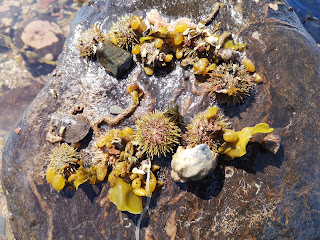Exploring biological classification using a diversity of live marine organisms including sea stars, sponge,
periwinkles, a brittle star,
sea anemones and more.
Creating a dichotomous key using seaweeds.
Studying the anatomy of a sea urchin using microscopes.
Conducting an experiment to determine if size affects the time it takes sea stars and urchins to flip right side up. Results: smaller sea stars were faster; sea stars were faster than urchins.
Testing the strength of echinoderms (common sea star, urchin, blood star & purple sunstar). The urchins were the strongest, with one holding 48x its own weight!!
Exploring the intertidal zone at low tide.
Hiding under the rocks the students found sea urchins,
tiny sea stars,
and sea slugs laying their eggs.
One group also found a soft shell clam and blue mussels.
On another beach the group searched for invasive green crabs.
There was a great range in sizes from less than 2cm up to 6cm.
Data was gathered on the size and gender of each crab. The group found and marked 78 crabs in one hour.
One student even found a rock gunnel fish!
Exploring the ARC which houses a collection of preserved specimens from the North Atlantic.
There are even a few specimens from other locations.
Student got to see a number of deep sea fish including the dragon fish.
baby blue shark
Playing the very competitive game of plankton bingo!
Does temperature affect the feeding rate of barnacles? What temperature is their optimum?





















































